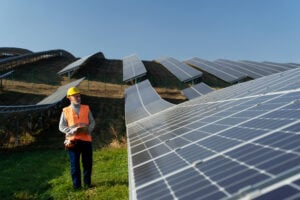In the past decade, solar energy has become an increasingly popular, accessible, and relatively affordable source of renewable energy.
An increasing number of households and businesses have adopted the use of solar panels, whether for economic or sustainability reasons, to reduce their dependence on non-renewable energy. However, at the same time, this creates demands for the proper disposal of solar panels once they reach the end of their life cycle.
Unfortunately, the disposal of solar panels comes with potentially significant environmental costs, leading to growing interest in proper solar panel disposal and recycling which can mitigate the negative impact on the environment.
In this article, we will delve into all you need to know about solar panel recycling, including but not limited to:
- The importance of solar panel recycling and proper disposal
- How solar panel recycling works and how much it costs
- The challenge it poses
- The current solutions available
And more.
Understanding the importance of proper disposal and recycling of solar panels can help us minimize the environmental impact of renewable energy sources. Let us begin by discussing the basics: what are solar panels made of?
What are solar panels made of?
To understand how solar panel recycling works and especially its challenges and costs, we have to first understand what solar panels are made of and how they work.
Solar panels are typically made of several key components:
- Solar cells: the most important part of solar panels, and are the ones responsible for converting sunlight into electricity. Made of silicon (a semiconductor material) that is capable of absorbing light energy and releasing electrons to create a flow of DC (Direct Current) electricity.
- Frame: typically made of aluminum, although there are solar panels with other materials for the frame. The frame’s role is to hold the whole solar panel together.
- Glass cover: the topmost layer of a solar panel is typically made of tempered glass to protect the other components. Glass is strong, durable, and can withstand exposure to bad weather and other elements while still providing transparency for the solar cells to receive direct sunlight.
- Encapsulation material: a layer or material (typically polymer such as EVA/ethylene-vinyl acetate), its role is to provide some insulation and prevent moisture from entering the solar panel
- Junction box: housing the electrical connections that allow the panel to generate electricity, serving as a conduit for electrical connections with the outside world. Also contains diodes that protect the solar panel by preventing the flow of DC electricity from reversing, which can damage the solar panel.
- Backsheet: the bottom layer of the solar panel, provides a physical barrier to protect the solar cells and other components and prevent moisture from entering the panel. Typically made of polymer.
Potential environmental impact of solar panel production, use, and disposal
As we can see from the solar panel components we’ve discussed above, there are potentially harmful chemicals and other materials used to make solar panels. Thus, although solar panels are often considered to be an environmentally-friendly energy source, they can still produce negative impacts on the environment and the health of those around the panels during the production, use, and disposal processes.
Below are some considerations.
Production:
- Raw materials: solar panel production requires extraction and processing of potentially impactful materials such as aluminum, copper, and silicon, among others. Processing these materials can be energy-intensive and can generate greenhouse gas emissions.
- Manufacturing: solar panel manufacturing processes may involve the use of chemicals and potentially hazardous solvents that may negatively impact the environment and the health of humans around it.
- Transportation: transporting the manufactured solar panels may result in additional emissions and there may be other negative environmental impacts.
Use:
- Land use: solar panels require land for installation, and their use may negatively impact the land depending on the location and how it is used. Installing solar panels on unused and undeveloped lands can, for example, impact the local ecosystems.
- Water use: solar panels do not require water during their use, but the manufacturing process of some of their components (i.e. inverters) may require a significant amount of water. Thus, using solar panels in areas where water quality is poor or where water is scarce can be concerning.
- Maintenance: while solar panels typically require little maintenance, cleaning the solar panels may require the use of potentially hazardous chemicals or solvents. They may be harmful when not used and managed properly.
Disposal:
Solar panels have a relatively long life expectancy and can last for several decades. Yet, eventually, they will need to be replaced. The thing is, disposing and recycling solar panels are processes that aren’t yet widely available so they can be expensive, creating a few concerns:
- Disposal: if not recycled, retired solar panels are typically buried in landfills, in which the components can release toxic materials into the soil over time. An alternative method is to incinerate the solar panels, a similarly harmful process that can release pollutants into the air.
- Recycling: solar panel components, as discussed, contain potentially hazardous materials such as selenium, lead, and cadmium. Recycling these materials can pose a risk to the humans involved, as well as the environment.
While we can consider the environmental impacts of solar panels to be relatively minimal compared to traditional non-renewable energy sources, there are still potentially negative impacts to be considered, especially during end-of-life management.
Proper recycling and disposal practices can help minimize these negative impacts, and may also help solar panel users maximize their ROI by ensuring the valuable materials of the solar panel are recovered for reuse.
You may also want to explore alternative options, such as selling used and old solar panels and equipment or repurposing to help reduce the overall environmental and health impacts of solar panels.
Challenges in recycling solar panels
In most cases, recycling the solar panel is the desired end-of-life management practice due to two key reasons: it is the most environmentally sustainable practice, and when done right it will also allow users to maximize the solar panel system’s ROI.
However, solar panel recycling is not yet widely available, and at the moment there have been several challenges that have hindered its adoption:
- Composition of solar panels. Solar panels are typically made of a complex mixture of materials that can vary depending on the type and manufacturer of the panel including glass, aluminum, silicon, and other chemicals and materials. This complex mixture of materials may make solar panels difficult to recycle, and some panels also contain toxic materials such as cadmium or lead, which may make the recycling process riskier and potentially hazardous.
- Lack of standardization. At the moment, there’s no standardization for recycling solar panels. This often makes it difficult for companies to know the right method to recycle solar panels from different manufacturers.
- Lack of infrastructure. Recycling solar panels is still a relatively new field, and there is currently limited infrastructure available for processing them. This is why many solar panels aren’t properly recycled or not recycled at all, and instead are just being disposed of in landfills.
- Lack of incentives. Unfortunately, there are often limited financial incentives for recycling. Thus, many organizations and individuals may think that recycling their solar panels is too expensive and simply not worth it, especially when they are required to invest in additional equipment and infrastructure.
- Environmental and health risks. Due to the difficulty of recycling solar panels and the fact that there are often potentially hazardous materials included in solar panel components; improper disposal of solar panels may result in serious environmental and health risks. The workers involved in recycling solar panels can be exposed to hazardous materials if they don’t follow safety protocols.
- Capacity: Due to the relatively slow growth of the solar panel recycling field, soon the field may not have the capacity to handle the rapidly increasing volume of solar panels that will be reaching the end of their life cycle in the near future.
- Varying cost: At the moment, the cost of recycling solar panels may vary depending on numerous factors, including but not limited to the type of panel, location, the number of materials that need to be recycled, and more. It can be difficult to establish a predictable, consistent pricing structure when recycling solar panels.
Current methods of solar panel recycling
As the need for solar panel recycling becomes increasingly important and at the same time solar panel technology continues to advance, various methods for recycling solar panels have been developed.
All of these methods and techniques aim to recover as many valuable materials as possible while minimizing waste and risks, but each approach comes with its own limitations and unique challenges.
With that being said, three solar panel recycling methods are considered the most cost-effective at the moment: mechanical, thermal, and chemical.
- Mechanical recycling process
This method—as the name suggests–involves physical (mechanical) disassembly and separation of materials, mainly via shredding and crushing. This process is mainly used to recover solid materials such as copper or aluminum, that can be sold as scrap.
Here are the general steps involved in the mechanical recycling process of solar panels:
- Transporting: the solar panels are removed from their mounting structure and then transported to the recycling facility.
- Sorting: the solar panels are dismantled, and then sorted by material, type, and component. For example, specific components such as aluminum frame, glass, and silicon cells are separated and sorted for further processing.
- Pre-processing: the sorted materials are pre-processed, mainly to remove any contaminants and other impurities. For example, the aluminum frame may be shredded into smaller pieces to remove impurities and for ease of processing.
- Processing: the pre-processed components are then sent through a series of machines that will further break the solar panels’ components down into smaller elements. For example, the silicon cells are beaten down into smaller pieces, and then sorted by type and purity.
- Recovery: the final step in this process is to recover the various (valuable) materials. For example, glass, aluminum, and silicon cells are recovered and can be sent to manufacturers so they can reuse them to manufacture new solar panels.
The mechanical process is typically the safest to perform compared to thermal and chemical methods, and it is also effective for recovering valuable materials from solar panels.Yet, it can be expensive due to the equipment/infrastructure needed.
However, this method cannot fully separate materials that are bonded or layered together in the solar panels. Also, some materials may be contaminated during the mechanical recycling process.
- Thermal recycling process
Thermal recycling techniques of solar panels involve heating the solar panels to high temperatures in the presence of oxygen or other flammable gases to break down the materials into their basic elements.
Here are the steps involved in the thermal recycling process:
- Transporting: the retired (or damaged) solar panels are collected (i.e. from households or solar farms) and then transported to a recycling plant.
- Pre-processing: the collected solar panels are pre-processed, mainly to physically remove any reusable materials, such as glass or aluminum frames.
- Heating: the remaining components; mainly solar cells and plastic components, are heated in a high-temperature furnace or oven. The heat will cause different materials in the panels to separate the components into their basic elements.
- Separation: the heated elements are separated using various methods, including hydro cyclone separation, gravitational separation, and air classification, among others. These methods will separate the heated elements such as silicon, aluminum, plastic materials, and glass from one another so they can be collected and purified.
- Purification: after the elements are separated, they are purified to remove any impurities. There are various purification methods available, for example, pyrometallurgy uses high temperatures to melt the elements and separate them based on their melting points. The goal of this stage is to remove any impurities left after the heating and separation process.
- Reuse/disposal: after the purification process, the leftover elements can either be reused or disposed of accordingly. Typically the silicon, aluminum, and glass elements are reused in the manufacturing process of new solar panels.
The main advantage of thermal recycling is its versatility and ease of implementation. It can easily handle a wide variety of solar panel types made of different materials, including those that are difficult to recycle using mechanical or chemical methods. Another advantage is that the high temperatures can help eliminate any hazardous materials that may be present in the solar panels.
However, the thermal recycling process is typically energy-intensive and the heating process may produce hazardous emissions such as nitrogen oxides and CO2. Not to mention the heating process may destroy some valuable materials that may otherwise be recovered in other recycling methods. This is why the thermal recycling process is typically considered the least favorable method for recycling solar panels.
- Chemical recycling process
Also known as hydrometallurgical recycling, this method involves the use of chemical substances to help dissolve the materials that made up the solar panels, separating them into their basic elements.
Here is the typical process of a chemical recycling process:
- Transporting: the retired solar panels are transported to a recycling facility capable of performing a chemical recycling process.
- Pre-treatment: before the actual chemical recycling process can be performed, the solar panels must be prepared in a pre-treatment stage. Here the glass and plastic material are manually removed from the panel, and the remaining panel is crushed so it can be processed further.
- Leaching: leaching refers to the process of dissolving the silicon cells in a specific chemical solution (typically a mixture of sulfuric acid and hydrochloric) to separate the silicon from other materials.
- Purification: once the silicon has been separated from the rest, it must be purified, for example with methods like filtration and distillation to remove impurities so it can be sold or reused.
- Recovery: the purified silicon and other valuable materials are separated and recovered so they can be used in the manufacturing process of new solar panels (or other products.)
The chemical recycling of solar panels can recover a high percentage of the materials (especially silicon) from other methods, but it is also more challenging and expensive to perform. Obviously, it is also riskier with the potentially hazardous chemicals used in the process, so this method typically requires specialized expertise and equipment /infrastructure.
Solar panel recycling: how much it actually cost
Solar panel recycling is often complex and costly, due to the various stages involved in the different methods used.
However, in virtually all methods, we can break down the costs for performing solar panel recycling as follow:
Fixed costs
There are two basic fixed-cost components for recycling solar panels: the capital investment in recycling infrastructure/equipment, and the costs of obtaining necessary permits and licenses.
The capital investment in recycling equipment can vary depending on the size and complexity of the recycling process, and where the facility is located, among other factors, but it can range from several hundred thousand to several million dollars.
Due to the relatively new field and the complexity of the process, obtaining the necessary licenses and permits can also be expensive, at least several thousand dollars annually.
As we can see, the expensive fixed costs can be a major barrier to entry for starting a solar panel recycling facility.
Variable costs
The variable costs of recycling solar panels include the cost of collection, transportation, and the actual recycling processing of solar panels:
- Collection costs: the cost of collecting the used/retired solar panels can be significant and shouldn’t be underestimated. It can range from $0.05 to $0.25 per watt, depending on the location, volume, type of solar panels being collected, and the methods used.
- Transportation costs: transportation costs of the collected solar panels to the recycling facility can include gas, labor, and vehicle maintenance costs, among others. The actual cost can vary, mainly due to the distance between the collection site and the recycling facility, but also other factors like the mode of transport used and the number of panels being transported. The cost of transportation can range from $1,000 to $2,000 per container, and each container can hold 300 to 500 solar panels.
- Processing cost: the cost of recycling solar panels can vary depending on the method used, size/type/quantity of the panels, and how much purification is needed. The typical cost of mechanical recycling is between $20 and $30 per panel.
Although the cost of recycling solar panels can vary, it’s worth noting that at the moment it is generally more expensive than producing new solar panels. Unfortunately, this phenomenon often discourages people from starting new recycling facilities, further driving the costs higher.
With that being said, efforts are underway to reduce the cost of solar panel recycling by:
- Developing more cost-effective solar panel recycling processes with more efficient waste management
- Implementing regulations and government incentives to offset costs
- Increasing the volume of recycled solar panels all around the world to lower the cost
- Establishing partnerships and collaborations to share resources
Recycle your solar panels with Solar Recycling™️
As the adoption of solar panels continues to grow all around the world, the need for cost-effective and safe recycling methods is becoming more pressing.
Proper recycling of solar panels at the end of their life cycle is critical for mitigating their environmental footprint while also lowering the cost of producing new solar panels.
While there are challenges associated with solar panel recycling and the fact that it is still relatively expensive, companies like Solar Recycling™️ offer safer and more cost-effective used solar panels recycling methods, and are paving the way in the effort to build a more environmentally responsible and sustainable solar industry.






